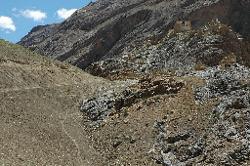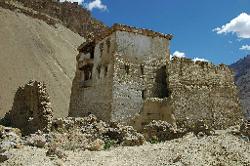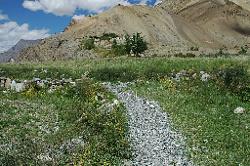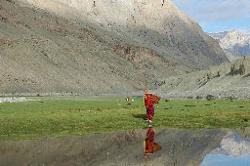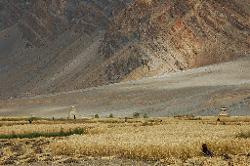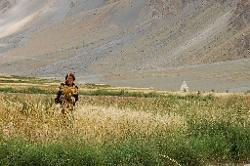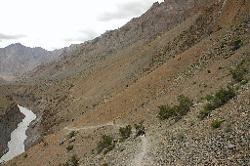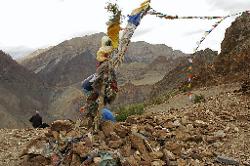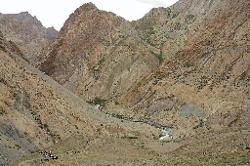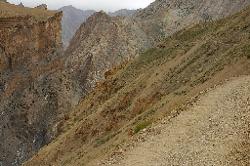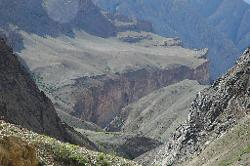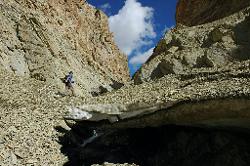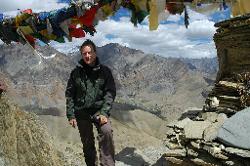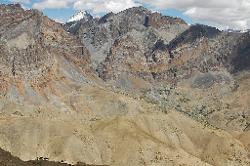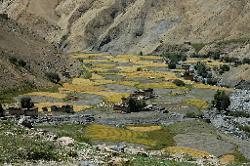MyHimalayasimpressions from |
|
|||||||

Ladakh to Zanskar: Zangla to Lingshed
Zangla Rest Day (Day 14)
I haven't slept that well in some time. Usually I wake up at the slightest noise and rarely sleep through till breakfast, but this night I was the only one not to hear the horse with a bell that was grazing just in front of our tents.
The wind has died down, it's a nice sunny day for a walk. It's a good place for a restday, there's plenty of grass for the horses and for us interesting day hikes. Andrea and I start early before it gets too hot, our goal is the nunnery and the fort of Zangla. It's a long walk across the pebble-covered plain. Distances are deceptive, but then we see the nunnery above us and climb up to it. Nobody seems to be there, then we hear the prayers from a separate building.
When a nun sees us she invites us into the sunny room where a puja is just going on. 8 nuns of various ages sit on the carpet near the window and recite texts from heart. A young nun whose expressions show her energy and feeling during the recital leaves a strong impression on me. The highest-ranking nun sits in the middle and hands out the key to the caretaker so she can get nice cups for our Ladakhi tea. After half an hour the prayer stops, we're offered chapati and have time for conversation. A group of Japanese tourists bursts in at the very moment, and we gladly take up the nun's offer of showing us around. Narrow corridors connect the buildings of the gompa, and the nun opens and unlocks the door at the end of the corridor.
The nunnery is 500 years old, and the main room does indeed look old. Just above the door are white paintings on black background, a technique that is quite rare. The two side walls feature paintings of various deities and historic figures. At the front wall are statues of Avalokiteshvara (Buddha of Compassion)and other protector deities. The statues and thangkas of the protector deities are covered by cloth, and are unveilled at special occasions only.
After a short chat we leave the pleasant place, and head towards the village. The village is empty and doesn't have much charm. Passing some mani walls with fine carvings, we climb up to the fort that stands on a crag in front of an even steeper mountain face. Countless chortens and more mani walls were erected below the fortress. What must this place have looked like in its hay-days? Who has walked up this trail? It must have been servants, villagers, but also emissaries, and kings and queens from neighbouring states. Which armies tried to invade, and were defeated? Some of the history is known, like that fact that the king showed the Dogra invaders the complicated way to the Indus valley via the Jumlam, from where they attacked Ladakh - in exchange of various favours. And that one of the first tibetologists, Körös, stayed in the fort for several months, studying the language, history and culture. But most other facts will probably never emerge. Rain has damaged the fort substantially, therefore the main door is locked.
We walk back via the fields below the village on pebble-strewn path that winds itself through fields of peas, grass and flowers, with the wide valley in the background and the nunnery on the hillside. Colourful butterflies get carried away by the wind, birds sing in the rosehip bushes. It's a wonderful afternoon, though the walk on the rock-covered plain to get to campsite is uneventful and a little dull.
Despite the strong wind we play a fine game of frisbee. Then the usual but still highly appreciated routine of pakora for afternoon snacks, a nap, then soup and great dinner. Ger and Daireen will leave tomorrow, and take the jeep to Padum and Leh. Their "replacement" who were supposed to join us here for the rest of the trek won't be able to come: one is seriously sick and the other will bring here back to Leh.
Zangla - Hanumal (Day 15)
My mood during trekking is closely related to the weather. The overcast sky does not make the walk on the barren plain any more interesting. We first walk on the road that is under construction and will in some years be the first road that connects Zanskar with Ladakh, even in winter because it does not go over passes. I'm glad to reach the bridge where we cross over to Pishu and leave the road behind. I'm not sure whether the recent rain has turned the village of Pishu into its sorry state, of it was always like this. Instead of white-washed houses, brick walls and construction sites dominate the village. I leave quickly.
The walk through the fields outside the village increase my mood a little. Wide fields of ripe barley cover the level ground, white chortens rise out of the golden fields and red barren slopes rise in the background. Not only kids but virtually everybody asks for sweets and money; on the one hand understandable if hordes of trekkers pass by, on the other hand it is annoying.
After the fields the trail follows the Zanksar upstream; sometimes right along the bank, sometimes a little above it. All in all, it's quite a "flat walk" compared to previous days, and I must admit, a little boring. I don't enjoy it very much; seeing roadworkers across the river blasting the road doesn't help to create a feeling of trekking in a remote area of the Himalayas.
At least it promises to be a short day; Hanumil is a little hamlet of two or three houses above the river with a nice campsite. It's much prettier than Pishu, and camping right under willow trees shortly after noon promises a long, lazy and enjoyable afternoon. The sun comes out after all, and despite the wind Martin and I play a great game of frisbee for most of the afternoon.
Hanumal - Parfi La - Snertse (Day 16)
My throat still hurts rather badly, it's hard to get rid of a cold up here. The cloudy sky isn't an incentive to start early either. The walk is similar to yesterday's at first; along the river slowly climber higher with a rather monotonous scenery. After a climb to a precipicious rest point the views promise to get better.
We leave the Zanskar river, branch off to the west and climb up towards the 3'950 m high Parfi La. My cold makes it a rather tedious climb, and when I reach the pass a cold wind forbids a long stay. A short glimpse is enough to reveal the walk after lunch: another climb up a steep slope.
The trail to get down to the creek called "oma chu" (milk water) used to be very bad, it seems to have been fixed and though it is quite steep and tripping or slipping has to be avoided at all costs, the trail itself is fine. After an hour of descending my knees hurt, and I rest at the simple hut that serves as a restaurant and shop. Well, after Joel buying the last cans of tuna fish the shop probably has to close becaise it ran out of supplies, but it seems to be the end of the season anyway. While we have lunch a few raindrops fall, no serious rain but enough to get started quickly.
After crossing the bridge the second or third of today's climb starts. It's a rather long one, but once atop the views are spectacular: the trail bends around a ridge and then traverses a steep hillside. Turning around, I see the Parfi La and the zig-zag trail we took to descend. The horses arrive, and manage the risky part of the trail without problems. I let them pass me and see them stop at the next creek where level tent spaces indicate we're not the first ones to camp here.
Snertse - Hanuma La - Lingshed (Day 17)
The reddish steep crags rise into the dark blue sky. Our caravan looks very small indeed, like ants. Despite good sleep my throat still isn't better, it burns and I can hardly swallow. Maybe it's the great sunshine, or maybe the prospect of an exhilarating walk, but despite the throat I feel very good. Hot ginger and honey water in the morning eased the pain temporarily. Andrea isn't feeling better, and will ride part of the way.
The rain has washed away most of the trails and it takes a little bit of route-finding in the first half hour. Steep climbs along the creek for awhile. When the trail flattens out there's still some tricky spots, like crossing an ice bridge that thaws, and a little bit of rock-climbing for short-cuts rather than out of necessity. There are great views down the valley where we came from.
When the steep canyons end we haven't reached the pass yet that is just a little below 5'000 m. The trail becomes even more level, and rolling hills rather than steep slopes are ahead of us. The white of water, black rocks in the riverbed and red valley walls are simple but effective play of colours. We pass a destroyed hut, pass some grazing yaks and trod slowly uphill. To be honest, the yaks have quite an intimidating posture, and for a Martin and I are ready to run if necessary. It's a long walk until we finally see the prayerflags flattering in wind, and even longer to reach them, with a throbbing heart, burning muscles and worst, a very dry throat.
On the way up I assumed this would be a great pass, since red mountain flanks and glaciered peaks were visible from further down. Still I'm not quite prepared for the scenery that opens up from the Hanumil La. The barley fields of Lingshed lie like in a bowl, white-washed houses in between the yellow fields, above tower steeps cliffs and snow-covered peaks. To the left are round hills, probably remains of glaciers, with good pastures. On the horizon far to the right, above canyons that deep inside the earth, a triangular summit of pure white is the most prominent mountain - though it looks like Kang Yaze it is definitely not. We stay for a long time at the pass, marvelling at the scenery.
Little lines cut across and traverse the many hillsides that lie between us and the clusters of houses that mark the monastery, and our campsite. So before getting to the center of the village that looks to temptingly close, we have to descend steeply to the creek, climb up a hill, and then walk all the way to the village. That we have to contour some more hills is not visible from high above, but adds to the long walk that awaits us after climbing the pass.
A long and steep descent, loosing all the hard-earned altitude, only to climb up again afterwards. It takes us almost as long to get from the pass to Lingshed than it took us from Snertse to the pass. Enjoying the views of the wide green fields and large village, plus the elaborate water channels, is a good distraction in the last hour. A wolf-trap indicates the village, but unlike the one above Zangla Doksa there are no bones of young sheep visible.
Passing houses and walking through fields, we reach the monastery and with heavy legs I count every additional step we have to take to get to the campground. How good it feels to sit down and stretch the legs. Even the kitchen crew is a little tired, they admit. But for them the workday hasn't really started yet; setting up kitchen, cooking snacks and dinner, while I enjoy the well-deserved rest.
Young novices from the monastery have a break and help us putting up tents. When one of them asks me for sweets, I scold him and tell him (half-seriously) if he's not ashamed to act like a beggar, being a lama. Later the monk tells Lobsang I called him a beggar, and Lobsang laughs for awhile.
|
Summary Part 5:
The former palace of Zangla resides on a steep hill overlooking
the valley. We leave the former kingdom and head back north to
Ladakh, following the Zanskar for two days. The walk along the
wide river is a little dull, when climbing away over the Parfi
La the scenery becomes more fascinating. On the way to Lingshed
we climb for a few hours up a colourful valley, pass yaks on the
way and are a little tired when reaching the Hanumil La. Our
efforts are rewarded, the views from the pass are spectacular:
Snow mountains, deep canyons, round moraine hills, and then the
green fields and white houses of the large village. We camp near
the monatery for two nights and enjoy the village life. |
